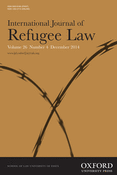-
Views
-
Cite
Cite
Tamara Wood, Expanding Protection in Africa? Case Studies of the Implementation of the 1969 African Refugee Convention’s Expanded Refugee Definition, International Journal of Refugee Law, Volume 26, Issue 4, December 2014, Pages 555–580, https://doi.org/10.1093/ijrl/eeu048
Close - Share Icon Share
Abstract
The expanded refugee definition in the 1969 African Refugee Convention has been widely praised for its broad scope, its humanitarian aspirations, and for inspiring the liberalization of refugee protection elsewhere. Paradoxically, relatively little is known or understood about its practical effect on refugee protection within Africa. While many African states have incorporated the expanded definition into their domestic refugee legislation, a lack of literature on its implementation makes it hard to assess the extent to which the definition has expanded protection in practice. In addition, a near total absence of available case law from African courts and tribunals means that even a basic understanding of its operation is difficult to establish.
Addressing this gap, this article considers the expanded refugee definition’s implementation in two case study countries – South Africa and Kenya. Drawing on fieldwork undertaken in both countries in late 2012, the article analyzes the definition’s incorporation into domestic law and the crucial step of its implementation within refugee status determination procedures. As two of the main refugee-receiving countries in Africa, the case studies provide a basis on which to assess whether the expanded protection envisaged by the definition is being realized in practice. To the extent that such protection is not being realized, this article offers some preliminary thoughts on why this is and how it might be improved.



